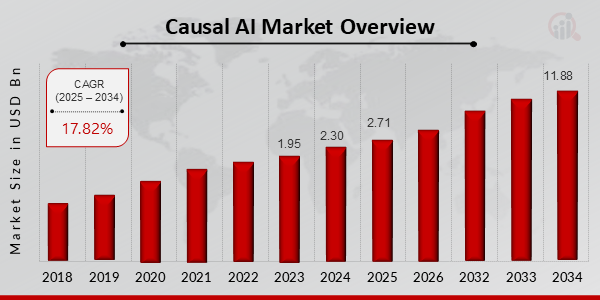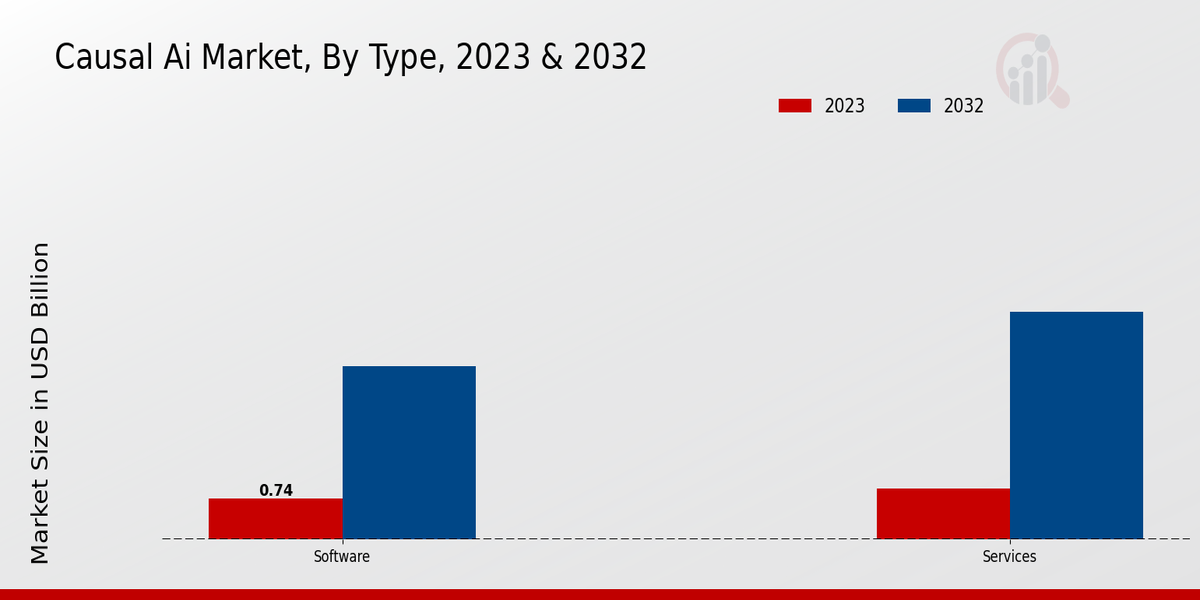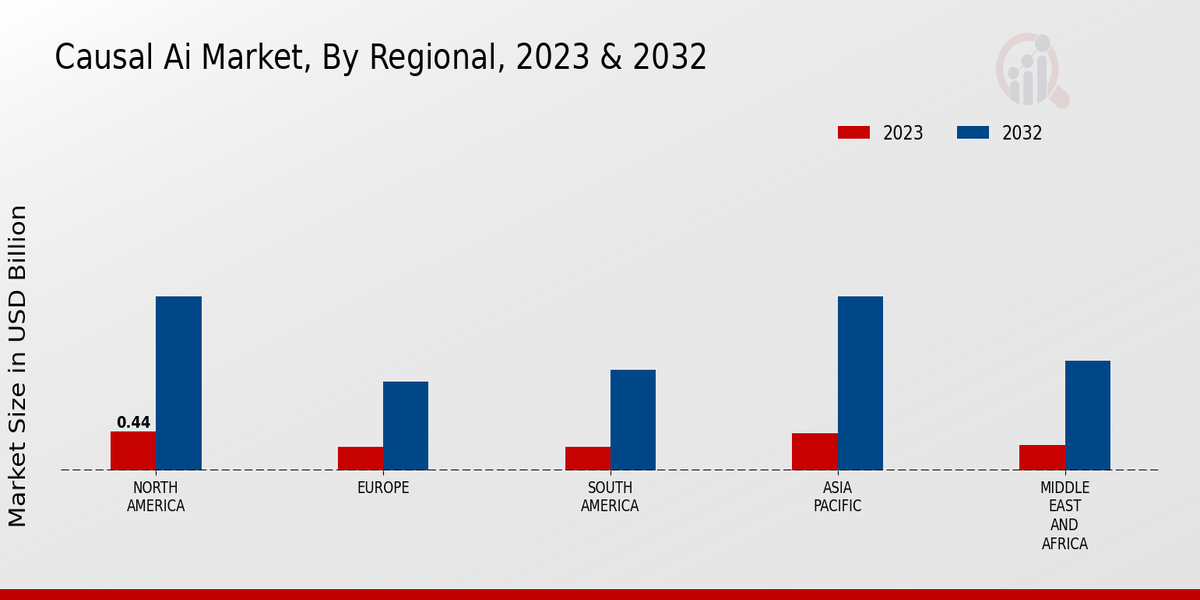Causal AI Market Overview
Causal AI Market is projected to grow from USD 2.71 Billion in 2025 to USD 11.88 Billion by 2034, exhibiting a compound annual growth rate (CAGR) of 17.82% during the forecast period (2025 - 2034).
Additionally, the market size for Causal AI Market was valued at USD 2.30 billion in 2024.
Key Causal AI Market Trends Highlighted
As more businesses look to understand cause-and-effect relationships in more detail, the need for Causal AI is rising globally. The desire for more accurate predictive analytics, the growing complexity of business environments, and the increasing acceptance of AI-driven decision-making are the main factors driving the industry.
Opportunities to explore and grab the market are abundant. There is a great deal of promise for increasing predictive skills and decision-making processes through the integration of Causal AI with other technologies, like data analytics and machine learning.
More opportunities for development are created by the growing use of Causal AI in supply chain management, finance, and healthcare.
Probabilistic causal models, which yield more precise and comprehensible results, are becoming more and more popular in the Causal AI sector. Additionally, organizations are finding it easier to use this technology thanks to the growing availability of Causal AI tools and platforms.
Its applications in disciplines like biology, economics, and social sciences are also growing because of the use of causal AI in scientific research.
Figure 1: Causal AI Market size 2025-2034

Source: Primary Research, Secondary Research, MRFR Database and Analyst Review
Causal AI Market Drivers
Growing Demand for Personalized and Contextual Insights
Organizations across various industries are increasingly seeking personalized and contextual insights to enhance decision-making, improve customer experiences, and optimize operations. Causal AI's ability to establish causal relationships between variables and accurately predict outcomes makes it a valuable tool for businesses looking to gain a competitive advantage.
By leveraging Causal AI, organizations can identify the root causes of business outcomes, optimize marketing campaigns, develop personalized recommendations, and make informed decisions based on data-driven insights.
The growing demand for personalized and contextual insights is expected to drive significant growth in the Causal AI market over the coming years.
Advancements in Machine Learning and Artificial Intelligence
The Causal AI Market has witnessed significant advancements in machine learning (ML) and artificial intelligence (AI), which have played a crucial role in the development and adoption of Causal AI solutions.
The integration of ML and AI techniques has enabled Causal AI models to analyze large and complex datasets, identify causal relationships, and make accurate predictions. These advancements have enhanced the capabilities of Causal AI solutions, making them more accessible and easier to implement for businesses of all sizes.
The continued progress in ML and AI is expected to drive the growth of the Causal AI Market further.
Increasing Adoption in Healthcare and Life Sciences
The healthcare and life sciences industries have emerged as key adopters of Causal AI, driven by the need for accurate and reliable insights to improve patient outcomes and accelerate drug discovery. Causal AI's ability to identify causal relationships between treatments and outcomes, predict progression, and optimize clinical trials holds immense potential for revolutionizing the healthcare industry.
By leveraging Causal AI, healthcare providers and researchers can gain a deeper understanding of disease mechanisms, develop more effective treatments, and improve patient care.
The growing adoption of Causal AI in healthcare and life sciences is expected to contribute significantly to the growth of the Causal AI Market in the coming years.
Causal AI Market Segment Insights
Causal AI Market Type Insights
The 'Type' segment of the Causal AI Market is bifurcated into Software and Services. Software held the largest market share in 2023, accounting for nearly 60% of the revenue. The dominance of software can be attributed to the increasing adoption of Causal AI algorithms and models in various industries.
Services, on the other hand, are projected to exhibit a higher CAGR during the forecast period. The growth of the services segment is driven by the rising demand for professional assistance in implementing and managing Causal AI solutions.
Enterprises are increasingly seeking expert guidance to optimize their use of Causal AI and derive maximum value from their investments. The Causal AI Market is expected to witness significant growth in the coming years due to factors such as the increasing need for accurate and reliable decision-making, the growing volume of data, and the advancements in machine learning and artificial intelligence technologies.
Asia-Pacific is projected to be the fastest-growing regional market, driven by the increasing demand for Causal AI in emerging economies such as China and India.
Key players in the Causal AI Market include IBM, Microsoft, Google, Amazon Web Services, and SAS Institute. These companies are investing heavily in research and development to enhance their Causal AI offerings and gain a competitive edge in the market.
Partnerships and collaborations are also becoming increasingly common in the industry as companies seek to combine their strengths and offer comprehensive solutions to customers.
Figure 2 : Causal AI Market By Condition, 2023 & 2032

Source: Primary Research, Secondary Research, MRFR Database and Analyst Review
Causal AI Market Application Insights
The Causal AI market is segmented into various applications, including natural language processing, computer vision, speech recognition, and machine learning operations. Natural language processing is a rapidly growing segment of the Causal AI market, with a market size of USD 1.23 billion in 2023 and is projected to grow to USD 4.35 billion by 2032, at a CAGR of 17.89%.
This growth is being driven by the increasing adoption of NLP technologies in various industries, such as customer service, healthcare, and finance.
Computer vision is another major segment of the Causal AI market, with a market size of USD 0.98 billion in 2023 and is projected to grow to USD 3.41 billion by 2032, at a CAGR of 17.98%. This growth is being driven by the increasing adoption of computer vision technologies in various industries, such as manufacturing, retail, and transportation.
Speech recognition is a growing segment of the Causal AI market, with a market size of USD 0.76 billion in 2023 and is projected to grow to USD 2.65 billion by 2032, at a CAGR of 18.05%. This growth is being driven by the increasing adoption of speech recognition technologies in various industries, such as customer service, healthcare, and education.
Machine learning operations (MLOps) is a relatively new segment of the Causal AI market, but it is rapidly growing. MLOps is a set of practices that helps businesses manage and deploy machine learning models more efficiently.
The MLOps market is expected to grow from USD 0.54 billion in 2023 to USD 2.12 billion by 2032, at a CAGR of 18.12%.
Causal AI Market Deployment Mode Insights
The Causal AI Market is segmented by deployment mode into cloud, on-premises, and hybrid. Among these, the cloud segment is expected to witness the highest growth rate during the forecast period. The increasing adoption of cloud-based solutions by businesses of all sizes is driving the growth of this segment.
Cloud deployment offers several benefits, such as scalability, flexibility, and cost-effectiveness, which are attracting businesses to adopt this deployment mode. The on-premises segment is expected to hold a significant market share during the forecast period.
However, the hybrid segment is expected to grow at a steady pace, as it offers the benefits of both cloud and on-premises deployment modes. Overall, the Causal AI Market is expected to witness significant growth in the coming years, driven by the increasing demand for AI solutions across various industries.
Causal AI Market Vertical Insights
The Causal AI Market is segmented vertically by industry into healthcare, financial services, manufacturing, and retail. The Healthcare segment dominated the market in 2023, with a market size of USD 0.56 billion and a CAGR of 18.2%.
The growth of this segment is attributed to the increasing adoption of Causal AI in healthcare applications such as disease diagnosis, treatment planning, and drug discovery. The Financial Services segment is expected to Register a CAGR of 17.9%, reaching a market size of USD 0.48 billion in 2023. This growth is driven by the increasing use of Causal AI in risk management, fraud detection, and customer segmentation.
The Manufacturing segment is expected to Register a CAGR of 17.6%, reaching a market size of USD 0.32 billion in 2023. The growth of this segment is attributed to the increasing adoption of Causal AI in predictive maintenance, quality control, and supply chain optimization.
The Retail segment is expected to Register a CAGR of 17.3%, reaching a market size of USD 0.29 billion in 2023. This growth is driven by the increasing use of Causal AI in personalized marketing, demand forecasting, and customer service.
Causal AI Market Regional Insights
The regional segmentation of the Causal AI Market offers valuable insights into the market's growth dynamics across different geographic regions. North America is anticipated to dominate the market, accounting for a significant share of the revenue in 2023.
The region's robust technology infrastructure, presence of key industry players, and high adoption rate of AI solutions contribute to its dominance. Europe follows closely, driven by increasing government initiatives and investments in AI research and development.
The APAC region is expected to witness substantial growth in the coming years, owing to rising demand for AI solutions in emerging economies like China and India.
South America and MEA are expected to experience steady growth, driven by increasing awareness of the benefits of Causal AI and growing investments in digital transformation.
Figure 3 : Causal AI Market By Regional, 2023 & 2032

Source: Primary Research, Secondary Research, MRFR Database and Analyst Review
Causal AI Market Key Players and Competitive Insights
Major players in the Causal AI Market are continuously engaging in strategic initiatives and collaborations to strengthen their market positions. Leading Causal AI Market players focus on offering innovative solutions, expanding their product portfolios, making significant investments in research and development, and forming strategic partnerships with other organizations.
The Causal AI Market development is fueled by the growing adoption of artificial intelligence (AI) and machine learning (ML) technologies across various industries like automotive, healthcare, financial services, and manufacturing.
Companies operating in the Causal AI Market Market are also focusing on providing comprehensive solutions that integrate Causal AI capabilities with other technologies, such as computer vision, natural language processing, and predictive analytics.
The Causal AI Market Competitive Landscape is characterized by the presence of both established players and emerging startups.
A prominent player in the Causal AI Market, Google, has been at the forefront of developing and deploying Causal AI solutions across its various products and services. Google's Causal AI capabilities are leveraged to improve the accuracy and effectiveness of its search engine, language translation services, and image recognition systems.
The company's investments in research and development and its commitment to open-source initiatives have contributed to its leading position in the market. Google's Causal AI solutions have also been adopted by businesses in various industries to enhance decision-making and improve operational efficiency.
Another key player in the Causal AI Market, Amazon, utilizes Causal AI to power its e-commerce platform and optimize its supply chain management systems. Amazon's Causal AI solutions improve product recommendations, enhance customer experience, and optimize pricing strategies.
The company's cloud computing platform, Amazon Web Services (AWS), provides access to Causal AI services, enabling businesses to incorporate Causal AI capabilities into their own applications and systems. Amazon's strategic partnerships with other organizations and its focus on developing industry-specific solutions have contributed to its strong position in the market.
Key Companies in the Causal AI Market Include
-
Causal AI
-
Sisu
-
Cogni
-
Oridion Systems
-
Judg.ai
-
Amelia.ai
-
Impact Genome
-
Causal
-
Nebula Labs
-
Unlearn.AI
-
Glencoe Software
Causal AI Market Developments
The Causal AI market is anticipated to grow significantly in the coming years, driven by increasing demand for data-driven decision-making, advancements in machine learning and artificial intelligence, and growing adoption across various industries.
Notable recent developments in the Causal AI market include the launch of new products and solutions by key players such as IBM, Microsoft, and Google.
Strategic partnerships, acquisitions, and collaborations are also shaping the market landscape. For instance, in 2023, Google Cloud partnered with the University of California, Berkeley, to establish a new research center focused on developing Causal AI technologies.
Causal AI Market Segmentation Insights
-
Causal AI Market Type Outlook
-
Causal AI Market Application Outlook
-
Causal AI Market Deployment Mode Outlook
-
Causal AI Market Vertical Outlook
-
Healthcare
-
Financial Services
-
Manufacturing
-
Retail
-
Causal AI Market Regional Outlook
-
North America
-
Europe
-
South America
-
Asia-Pacific
-
Middle East and Africa
|
Report Attribute/Metric
|
Details
|
|
Market Size 2024
|
2.30 (USD Billion)
|
|
Market Size 2025
|
2.71 (USD Billion)
|
|
Market Size 2034
|
11.88 (USD Billion)
|
|
Compound Annual Growth Rate (CAGR)
|
17.82% (2025 - 2034)
|
|
Report Coverage
|
Revenue Forecast, Competitive Landscape, Growth Factors, and Trends
|
|
Base Year
|
2024
|
|
Market Forecast Period
|
2025 - 2034
|
|
Historical Data
|
2019 - 2023
|
|
Market Forecast Units
|
USD Billion
|
| Key Companies Profiled |
Causal AI, Sisu, Cogni, Oridion Systems, Judg.ai, Amelia.ai, Impact Genome, Causal, Nebula Labs, Unlearn.AI, Glencoe Software |
| Segments Covered |
Type, Application, Deployment Mode, Industry Vertical, Regional |
| Key Market Opportunities |
1 Healthcare Improve causal understanding of medical interventions 2 Finance Enhance risk assessment and predictive modeling 3 E-commerce Personalize customer experiences and optimize marketing campaigns 4 Transportation Optimize traffic management and logistics 5 Industrial IoT Improve equipment maintenance and predictive maintenance |
| Key Market Dynamics |
1 Growing Demand for Explainable AI 2 Advancements in Causal Inference Algorithms 3 Increasing Adoption in Healthcare and Finance 4 Integration with Machine Learning Models 5 Regulatory Compliance and Data Privacy Concerns |
| Countries Covered |
North America, Europe, APAC, South America, MEA |
Frequently Asked Questions (FAQ) :
The Causal AI Market is expected to reach a valuation of USD 11.88 Billion by 2034, exhibiting a CAGR of 17.82% from 2025 to 2034.
North America and Europe are the dominant regions in the Causal AI Market, accounting for a significant share of the market. Asia-Pacific is expected to witness the highest growth rate during the forecast period due to increasing adoption of AI technologies.
Causal AI finds applications in various domains, including healthcare, finance, manufacturing, and transportation. It is used for tasks such as personalized medicine, fraud detection, predictive maintenance, and autonomous driving.
Major players in the Causal AI Market include IBM, Microsoft, Google, Amazon, and Oracle. These companies offer a range of Causal AI solutions and services to meet the diverse needs of customers.
The growth of the Causal AI Market is attributed to factors such as increasing demand for personalized and data-driven insights, rising adoption of AI technologies, and growing awareness of the benefits of Causal AI.
The Causal AI Market faces challenges such as data availability and quality, algorithm interpretability, and ethical concerns. However, ongoing research and advancements are addressing these challenges.
The Causal AI Market is projected to reach a valuation of USD 2.71 Billion by 2025, exhibiting a CAGR of 18.5% from 2024 to 2025.
The COVID-19 pandemic has accelerated the adoption of AI technologies, including Causal AI. The need for data-driven insights and automated decision-making has increased during the pandemic, driving the growth of the Causal AI Market.
Key trends shaping the Causal AI Market include the integration of Causal AI with other AI technologies, the development of explainable AI algorithms, and the increasing adoption of Causal AI in cloud-based environments.
Causal AI has the potential to revolutionize the healthcare industry by enabling personalized medicine, improving disease diagnosis and treatment, and optimizing healthcare operations. It can be used for tasks such as drug discovery, patient risk prediction, and treatment planning.
















